|
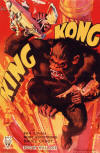 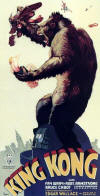 The chief distinctions of this famed monster picture
are conceded in the area of techniques―in the skill of manipulation of its
miniatures and trick photography—and
on the level of popular entertainment achieved with these mechanical effects;
but they are seldom considered sufficiently adult to assign it to the ranks of
the elite. King Kong is usually classed by highbrow critics among the lower
order of cinema freaks, or among the higher order of what they lightly term
kitsch or "camp." The chief distinctions of this famed monster picture
are conceded in the area of techniques―in the skill of manipulation of its
miniatures and trick photography—and
on the level of popular entertainment achieved with these mechanical effects;
but they are seldom considered sufficiently adult to assign it to the ranks of
the elite. King Kong is usually classed by highbrow critics among the lower
order of cinema freaks, or among the higher order of what they lightly term
kitsch or "camp."
Yet, I find this fantastic fable of the capture of a giant primeval ape in an
anachronistic, prehistoric jungle and its removal to the alien environment of
New York City, where it breaks loose in a surge of love for a human female and
is finally destroyed atop the Empire State Building, to be a pictorial allegory
with implications more spacious and profound than had ever before been generated
in a mere monster or science-fiction film. It is a pure photographic phantasm in
which the range of the evolution of man from primate to urban cliff-dweller is
spanned in one imaginative conceit, and several ironies of social imbalance are
remarkably and morbidly symbolized.
I am sure that most of the millions who have seen and thrilled to this film
in its perennially popular circulations have not calculated what it is about
it that stirs their apprehensions and leaves them troubled and even
distressed. Most viewers simply see it as an uncommonly awesome and amusing
monster film. And I suspect that if they were confronted by the suggestion
that it seeds their minds with a series of subconsciously connective and disturbing images-images of the brutality and cruelty of
civilized man, of the enslavement of the
strong but ignorant masses, especially those of the Negro race; of the
frustration of sex in a society dominated by machines―they would laugh
at such an idea, as they laugh at much in the film—until they thought about it. Then they might see why I have picked this film.
King Kong is a prime example of a composite. It was compositely fabricated
entirely in a studio, with miniature animated models of prehistoric beasts,
including that of the monster hero, Kong, which was only eighteen inches high.
These models were animated and photographed on strips of film with blank
backgrounds, and these were superimposed on matching photographs of live human
action, fanciful paintings of jungle settings and such, to achieve the completed
picture. And it was a composite in concept, being a conscious combination of the
classic monster-picture plot with the currently expanding conventions of the
popular true-life travel-adventure films.
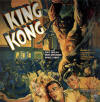 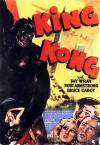 It follows closely the pattern of The Golem, first made in Germany in 1915,
which tells of a medieval statue into which a rabbi imparts life and which then
falls in love with a young woman, only to be repulsed by her. Driven mad by this
frustration, the creature goes berserk and plunges to death from a high tower. This is the basic pattern of most of the German monster films, which were made
during the 1920's, and the series of films about deformed humans and frustrated
freaks made by the ingenious Lon Chaney—The
Hunchback of Notre Dame (1923), The Phantom of the Opera (1925), London After
Midnight (1927). Such films of fanciful occurrence were extremely popular. It follows closely the pattern of The Golem, first made in Germany in 1915,
which tells of a medieval statue into which a rabbi imparts life and which then
falls in love with a young woman, only to be repulsed by her. Driven mad by this
frustration, the creature goes berserk and plunges to death from a high tower. This is the basic pattern of most of the German monster films, which were made
during the 1920's, and the series of films about deformed humans and frustrated
freaks made by the ingenious Lon Chaney—The
Hunchback of Notre Dame (1923), The Phantom of the Opera (1925), London After
Midnight (1927). Such films of fanciful occurrence were extremely popular.
But in King Kong, this formula was combined with the character and atmosphere of
the then increasingly
more popular travel and wildlife films. Indeed, Ernest Schoedsack and Merian C.
Cooper, who made King
Kong, had distinguished themselves originally with this type of
stranger-than-fiction film. Their Grass (1925) is a magnificent documentary of
migratory herdsmen in Persia, and their Chang (1927) is an excellent
documentary-fiction film that tells of a primitive family living in the jungle
of Siam. These films, along with such others as Robert Flaherty's Moana (1926),
W. S. van Dyke's Trader Horn (1931) and Frank Buck's Bring 'Em Back Alive
(1932), had served to acquaint the public with wild and exotic areas and
condition its abundant credulity for geographical and zoological caprice. Thus
the illusory power of the motion picture gave a certain plausibility to the
totally unscientific anthropological fantasy of King Kong.
An appeal to this power of illusion is made at the beginning of the film, with a
realistic simulation of a
travel film enterprise. An expedition is departing New York City for an
uncharted island in the Indian Ocean off Sumatra, where the expedition's
director has learned there is a fantastic collection of strange beasts. It is
his intention to make a motion picture of this mysterious place.
It is notable that Robert Armstrong, who plays Denham, the director, bears a
certain resemblance to Frank Buck and has much the same quality of a carnival
showman that Buck had. Also the fact that Denham picks up a beautiful, starving
girl off the streets of New York on the night before departure to go along and
play the heroine in his film had a similarity to the much-publicized episode of
W. S. van Dyke selecting an unknown, inexperienced female extra to take to
Africa to play the White Goddess in his location-made Trader Horn.
 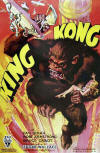 Schoedsack and Cooper have also continued to emphasize the real-life nature of
the expedition, with the motion-picture camera conspicuous on the deck of the
ship to make test shots and do rehearsals with the inexperienced girl, played by
Fay Wray. It is only as they approach the mystery island, known as Skull Island
because it has a mountain on it that looks like a skull, that they begin to
intrude the air of menace that was conventional in jungle films. Mists hang
around the island, great black birds hover over it and Max Steiner's monitory
music rumbles ominously. Schoedsack and Cooper have also continued to emphasize the real-life nature of
the expedition, with the motion-picture camera conspicuous on the deck of the
ship to make test shots and do rehearsals with the inexperienced girl, played by
Fay Wray. It is only as they approach the mystery island, known as Skull Island
because it has a mountain on it that looks like a skull, that they begin to
intrude the air of menace that was conventional in jungle films. Mists hang
around the island, great black birds hover over it and Max Steiner's monitory
music rumbles ominously.
The arriving expedition discovers one end of the island to be separated from the
vast interior by a great wall. It is on the other side of this wall, says
Denham, that the strange animals live. As the people from the ship approach the
near end, where the human inhabitants dwell, they hear the thumping of drums and
a weird chant rising from a thousand human throats, "Kong! Kong! Kong!" Then
they see through the trees the eerie glow of a strange, wild ceremonial taking
place. The natives, some dressed as gorillas, are dancing in a circle around an
altar to which a terrified native girl is lashed. When they spy the people from
the ship, and especially the white girl, Ann, they become greatly excited. They
want the "golden girl" to give as a sacrifice to Kong. Here is the first
suggestion of the appeasement of this mysterious beast, this creature that calls
up an image of the legendary minotaur, with the flesh of a human female. And the
further suggestion that the beast would be gratified with white flesh enhances
the erotic hint.
Of course, Denham and the ship's captain refuse the witch doctor and the native
chief when they demand that Ann be turned over to them. But that night the
natives kidnap her and take her back to the island, where they prepare her for
sacrifice. They tie her to a large stake and place this in the ground on the far
side of the wall; then they strike a huge gong to summon Kong from the interior
and line the top of the wall to watch.
Now, out of the twisted trees and giant vines rises the huge black shape of the
dreaded gorilla, with his great hideous face and shining eyes. Ann twists and
writhes in terror, but of course there is no hope, as the menace music thumps
like a heavy heartbeat and smoke from a hundred torches rises into the night.
With his eyes flashing anticipation, Kong deftly lifts Ann from the stake and,
clasping her to his vast chest, lumbers off into the jungle beyond the wall.
No sooner has this happened than a group of men from the ship arrive, led by
Jack, the mate, who has by
now become enamored of Ann. When they learn what has happened to her, they
boldly plunge into the jungle beyond the wall, hopefully going to her rescue—and
thus do we plunge from the initial period of comparative reality into the first
phase of pure fantasy. For here, in the depths of this strange jungle, the men
encounter giant beasts. "Something from the dinosaur family" is brought down
with a gas bomb. While crossing a lake on a makeshift raft, they are attacked by
a giant water monster.
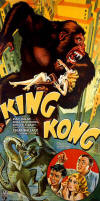  On ahead, Kong, with Ann in his giant paw, comes upon one of the men on a log
bridge. Very gently, Kong sets the girl on the ground, heroically thumps his
chest a few times, then grandly destroys bridge and man. Ann escapes, but Kong
rushes to her when he hears her screams and rescues her from a huge lizard in a
marvelous prehistoric wrestling match. Kong wins, of course. He ends the battle
by ripping the lizard's jaws apart, then tries, in his mute way, to show Ann
that he is very fond of her—with
the mood music slyly helping him. On ahead, Kong, with Ann in his giant paw, comes upon one of the men on a log
bridge. Very gently, Kong sets the girl on the ground, heroically thumps his
chest a few times, then grandly destroys bridge and man. Ann escapes, but Kong
rushes to her when he hears her screams and rescues her from a huge lizard in a
marvelous prehistoric wrestling match. Kong wins, of course. He ends the battle
by ripping the lizard's jaws apart, then tries, in his mute way, to show Ann
that he is very fond of her—with
the mood music slyly helping him.
Later on, there's another thrashing battle between Kong and a huge water snake,
and yet another with a giant pterodactyl on a mountain ledge. But while this
struggle is raging, Jack arrives and makes off with Ann, a perilous maneuver
which Kong tries in vain to prevent.
Meanwhile, back at the wall, the scattered crewmen have reassembled and are
wondering what to do, when Ann and Jack emerge from the jungle, with Kong
crashing through not far behind. The giant ape, fired with passion, pushes down
the gate, scatters the terror-stricken natives and goes after the whites, who
are trying to escape in a boat. As a last delaying maneuver, they fling a gas
bomb at the ape and, sure enough, it stops him. He falls anesthetized in his
tracks! Now Denham realizes what a treasure they can have by lashing Kong in
chains and taking him back to America. "We're millionaires, boys!" he exults.
"I'll share it with all of you! We'll have his name up in lights on Broadway: Kong, the Eighth Wonder of the World."
Dissolve now to the inside of a theater. Denham comes out on the stage to
introduce the show. "We
have brought back the living proof of our adventure," he says. The curtains open
and there on a platform is
the heavily shackled Kong, and on the stage beside the platform stands Ann in an
evening gown. "Look at
Kong," shouts Denham. "He was a god in his world!" The great ape wrenches at his
shackles. "There the beast and here the beauty!"
Then Jack is brought on in dinner jacket to pose with Ann for photographers and
to announce the romantic culmination of the expedition. But Kong, seeing him, is
infuriated with jealousy and hate. Further, the surprise of the photographers'
flashes causes him to leap with fear. With a great crash and rending, Kong pulls
free from his chains. The audience flees in panic. Kong breaks through the wall
of the theater and terrifies pedestrians and motorists as he bursts into the
street. Making straight for the building into which Jack has fled with Ann, he
scales the outside of it, shoves his huge arm through the window of the room in
which the two are fearfully cringing, grabs Ann in his giant paw and departs
with her over the rooftop and then down the outside of the building to the
street below. Still clasping his precious handful, he rips up the elevated
tracks and looms in front of an oncoming train which crashes calamitously
through the gap he has made.
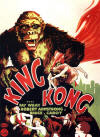  The city is in an uproar. Police are calling for help. Now a flash goes out over
the radio: "Kong is climbing
the Empire State Building!" And, in a splendid distance shot we see the creature—superimposed,
of course—climbing
up the outside of the familiar pylon-topped skyscraper. The city is in an uproar. Police are calling for help. Now a flash goes out over
the radio: "Kong is climbing
the Empire State Building!" And, in a splendid distance shot we see the creature—superimposed,
of course—climbing
up the outside of the familiar pylon-topped skyscraper.
Perched on the top of the pylon, with Ann clasped in his hairy paw, Kong is the
symbolization of the gross power of primitive, emerging man. Then modern man—civilization—calls
forth the ultimate weapon to bring him down-airplanes—and
in a moment, a swarm of them converges on the tower. As they near Kong and start
firing at him with machine guns, he gently places Ann on a narrow ledge, and,
with his arm thus free, lashes wrathfully at the planes which seem like tiny
gadflies as they swoop past. He catches one plane that ventures too close and
flings it, crumpled, to the street far below. But it is in vain. He is hit again
and again by screaming bullets. He picks up Ann for a last loving, tender-eyed
caress—all
he has ever been able to show her—while
she cringes in horror, then places her back on the ledge.
Now the great brute wobbles. His hideous face shows crinkled agony. Then he lets
go of the pylon and
plunges at last to the ground. On the street below, policemen and reporters are
gathered around Denham. "Well," says one, "the airplanes got him." And Denham
sadly and solemnly replies with what is clearly a
howling understatement, "Oh, no, 'twas beauty killed the beast."
No matter how used to the illusions of motion pictures one may be, there is an
irresistible excitement to
be got from this fanciful film, outside of the wildly imaginative tale it spins.
Perhaps the freakish power of its suggestion pricks some depth of atavistic
fear, touches some subconscious stratum of primitive animal dread. Kong is more
physically substantial and therefore less difficult to believe than the monsters
evolved out of statues or the gruesome specimens of human deformity. And since
he is a manifest of nature, he becomes an affecting metaphor just as do all
folk-tale animals when they are presented as symbolizations of humankind.
Remember, King Kong was initially released in March 1933, at the depth of the
Great Depression, when millions
were out of work and a sense of inhuman betrayal
by the social system was surging through the
land. Though critics and audiences did not bail it as an allegory of the times,
nor did Kong leap forth as a
symbol of the helpless working man, there was obviously some strange empathy
felt toward this cruelly
badgered beast by millions of unemployed who saw the picture in 1933.
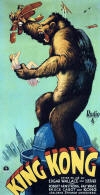 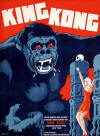 Likewise there is inducement for subconsciously sensing Kong as a massive
symbolization of the segregated Negro race. Kong is black. He is taken from the
jungle and transported to America in chains. Here he is used to serve a white
master who exploits him unmercifully. Likewise there is inducement for subconsciously sensing Kong as a massive
symbolization of the segregated Negro race. Kong is black. He is taken from the
jungle and transported to America in chains. Here he is used to serve a white
master who exploits him unmercifully.
But most suggestive and pervasive in the picture is the theme of frustrated sex,
which is superficially
funny but essentially sad and ominous. An irony (undoubtedly unintended) is that
poor old Kong finally
retreats to the top of the Empire State Building, which is—or
was, until its peak was adorned with spiky television antennae—the
most elaborate phallic symbol in the world.
King Kong was immensely popular. It is the only film that ever played the Radio
City Music Hall and the Roxy Theater in New York simultaneously. The figure of Kong became synonymous
with the concept of
superhuman strength and quickly merged into the folklore of our mechanical age. |
